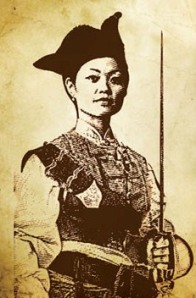The Sator square is a square that reads the same forwards, backwards, upwards and downwards:
| S | a | t | o | r |
| A | r | e | p | o |
| T | e | n | e | t |
| O | p | e | r | a |
| R | o | t | a | s |
The square has been found at many places around the world: on amulets, carved into walls or stones, written on disks used for extinguishing fire, and so on. Its first known appearance is in the ruins of Pompeii. The square was found in a building that was decorated in a style that became popular since the year 50. Pompeii was covered in ash from the Vesuvius in the year 79, and it follows that this example is almost 2000 years old. This makes the square one of the oldest known palindromes.

What does the Sator square mean? Except for `Arepo', scholars mostly agree on the meaning of the individual words. `Sator' is the seeder, sower, or begetter. It is also used as a metaphor for God, not necessarily Christian, but also Roman. `Tenet' is a verb, and means it, he or she holds. `Opera' is often considered to mean with effort. It is related to opus or opera, which means work. Finally, `Rotas' is generally considered a noun, meaning the wheels. But it might also be a verb meaning turn. Nobody has ever found a word in Roman, Greek, Etruscan, or any Indo-European language that explains `Arepo'. Some people think that it is a name, others that it stands for plough, misspelled to fit the palindrome, and yet others that it is just nonsense. For a long period, people thought the square had a Christian meaning by rearranging the letters into two Pater Nosters in the form of a cross. The Pre-Christian Pompeii find crushed this theory. If Arepo is a name, the Sator square might read: `The sower Arepo holds the wheels with effort', and if it stands for plough, you might get: `God holds the plough, but you turn the furrows'. According to John Cullen, this could have been a motto for farmers in Roman times. Most explanations I have read call the Sator square an ancient meme, with as much meaning as the sentence `all your base are belong to us'. In 1937, the Italian Antonio Ferrua probably gives the best explanation for what the square means: `Esattamente quello che si vuole'(!) E basta di questo argumento (it means exactly what you want it to mean. And so much for that argument!). The Sator square is an example of a meme that went viral long before the internet.
Because it is a palindrome, the Sator square was thought to have many healing effects, curing snake-bites, headaches, jaundice, and many other illnesses. Medieval books mention the square as a cure for fever and insanity. Interestingly, although we now know that using words to cure an illness is of little help, we humans do use palindromes to repair our body. I will say more about this in a later blog post on palindromes in DNA.
The amount of human effort gone into explaining the meaning of the Sator square is unbelievable. Since 1889, when Francis John Haverfield described a find of the square in a Romano-Bristish building in Cirencester, there has been a steady stream of articles on the Sator square, and the total number of articles easily surpasses a hundred. Rose Mary Sheldon recently published a 54-page annotated biography of the literature on the Sator square: The Sator rebus: An unsolved cryptogram? Charles Douglas Gunn wrote his PhD thesis on the square at Yale in 1969. He suggests that the square was written by a Roman who wanted to take palindromic squares one step further from the misformed four-letter word square Roma tibi subito montibus ibit amor, meaning `For by my efforts you are about to reach Rome, the object of your travel'. He wrote software to generate all possible five-letter Latin word squares. These squares take up more than a hundred pages in his thesis. He concludes that the Sator square is the best.


